人教版英语六年级上册 专题 句型(一)
(完整版)人教版六年级英语上册各单元知识点汇总
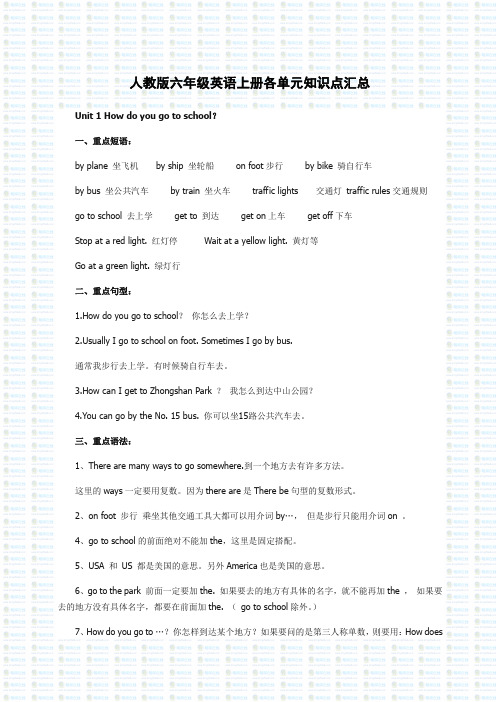
人教版六年级英语上册各单元知识点汇总Unit 1 How do you go to school?一、重点短语:by plane 坐飞机by ship 坐轮船on foot步行by bike 骑自行车by bus 坐公共汽车by train 坐火车traffic lights 交通灯traffic rules交通规则go to school 去上学get to 到达get on上车get off下车Stop at a red light. 红灯停Wait at a yellow light. 黄灯等Go at a green light. 绿灯行二、重点句型:1.How do you go to school?你怎么去上学?ually I go to school on foot. Sometimes I go by bus.通常我步行去上学。
有时候骑自行车去。
3.How can I get to Zhongshan Park ?我怎么到达中山公园?4.You can go by the No. 15 bus. 你可以坐15路公共汽车去。
三、重点语法:1、There are many ways to go somewhere.到一个地方去有许多方法。
这里的ways一定要用复数。
因为there are是There be句型的复数形式。
2、on foot 步行乘坐其他交通工具大都可以用介词by…,但是步行只能用介词on 。
4、go to school的前面绝对不能加the,这里是固定搭配。
5、USA 和US 都是美国的意思。
另外America也是美国的意思。
6、go to the park 前面一定要加the. 如果要去的地方有具体的名字,就不能再加the ,如果要去的地方没有具体名字,都要在前面加the. (go to school除外。
)7、How do you go to …?你怎样到达某个地方?如果要问的是第三人称单数,则要用:How doeshe/she…go to …?8、反义词:get on(上车)---get off(下车)near(近的)—far(远的)fast(快的)—slow(慢的)because(因为)—why(为什么)same(相同的)—different(不同的)9、近义词:see you---goodbye sure---certainly---of course10、频度副词:always 总是,一直usually 通常often经常sometimes 有时候never 从来不Unit 2 Where is the science museum?一、重点短语:library 图书馆post office 邮局hospital医院cinema 电影院bookstore书店science museum科学博物馆turn left向左转turn right 向右转go straight 直行north北south南east东west西next to靠近、与……。
PEP人教版英语六年级上册 各单元重点词汇句型归纳整理
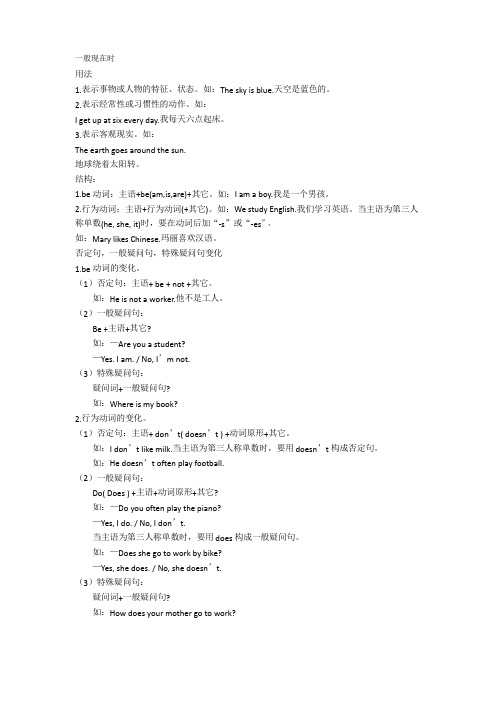
一般现在时用法1.表示事物或人物的特征、状态。
如:The sky is blue.天空是蓝色的。
2.表示经常性或习惯性的动作。
如:I get up at six every day.我每天六点起床。
3.表示客观现实。
如:The earth goes around the sun.地球绕着太阳转。
结构:1.be动词:主语+be(am,is,are)+其它。
如:I am a boy.我是一个男孩。
2.行为动词:主语+行为动词(+其它)。
如:We study English.我们学习英语。
当主语为第三人称单数(he,she,it)时,要在动词后加“-s”或“-es”。
如:Mary likes Chinese.玛丽喜欢汉语。
否定句,一般疑问句,特殊疑问句变化1.be动词的变化。
(1)否定句:主语+be+not+其它。
如:He is not a worker.他不是工人。
(2)一般疑问句:Be+主语+其它?如:—Are you a student?—Yes.I am./No,I’m not.(3)特殊疑问句:疑问词+一般疑问句?如:Where is my book?2.行为动词的变化。
(1)否定句:主语+don’t(doesn’t)+动词原形+其它。
如:I don’t like milk.当主语为第三人称单数时,要用doesn’t构成否定句。
如:He doesn’t often play football.(2)一般疑问句:Do(Does)+主语+动词原形+其它?如:—Do you often play the piano?—Yes,I do./No,I don’t.当主语为第三人称单数时,要用does构成一般疑问句。
如:—Does she go to work by bike?—Yes,she does./No,she doesn’t.(3)特殊疑问句:疑问词+一般疑问句?如:How does your mother go to work?一般过去时一、一般过去时的概念一般过去时表示过去某个时间发生的动作或状态。
小学英语六年级上册人教版第一单元复习
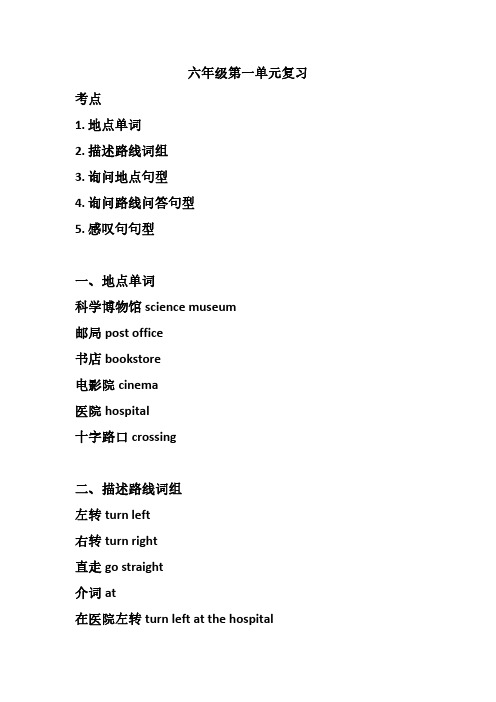
六年级第一单元复习考点1.地点单词2.描述路线词组3.询问地点句型4.询问路线问答句型5.感叹句句型一、地点单词科学博物馆science museum邮局post office书店bookstore电影院cinema医院hospital十字路口crossing二、描述路线词组左转turn left右转turn right直走go straight介词at在医院左转turn left at the hospital在邮局左转turn left at the post office在书店右转turn right at the bookstore在电影院右转turn right at the cinema在十字路口直走go straight at the crossing二、询问地点句型句型问:Where is+地点?答:It's+方位介词+地点.1.医院在哪?在电影院旁边。
Where is the hospital?It’s near the cinema.2.电影院在哪?紧挨着科学博物馆。
Where is the cinema?It’s next to the science museum.3.书店在哪?在邮局的前面。
Where is the bookstore?It’s in front of the post office.三、询问路线句型句型问:How can+主语+get there?How can+主语+get to+地点?答:Turn right/Turn left/go straight+at+地点.1.我们如何到达那儿?How can we get there?2.我如何到达那儿?How can I get there?3.我如何到科学博物馆?How can I get to the science museum?4.我如何到学校?How can I get to school?5.我们如何到达电影院?How can we get to the cinema?6.我们如何到达邮局?How can we get to the post office? 7.我们如何到家?How can we get home?四、感叹句句型句型结构What a/an+形容词+名词!1.多么有趣的电影啊!What an interesting film!2.多么棒的博物馆啊!What a great museum!3.多么漂亮的房间呀!What a nice room!。
人教版PEP英语六年级英语上册各单元单词短语句型全总结
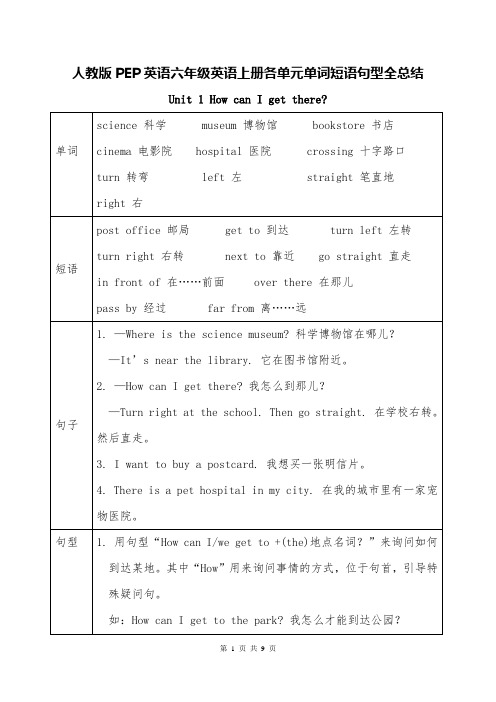
Unit 3 My weekend plan
单词
visit 拜访 film 电影 trip 旅行
supermarket 超市 evening 晚上;傍晚 tonight 在今晚
tomorrow 明天 dictionary 词典 comic 滑稽的
right 右
短语
post office 邮局 get to 到达 turn left 左转
turn right 右转 next to 靠近 go straight 直走
in front of 在……前面 over there 在那儿
pass by 经过 far from 离……远
句子
1. —Where is the science museum? 科学博物馆在哪儿?
businessman 商人;企业家 fisherman 渔民
scientist 科学家 pilot 飞行员 coach 教练
短语
police officer 警察 factory worker 工厂工人
head teacher 校长 look like 看起来像
lots of 许多;大量的 healthy life 健康的生活
—He works in a car factory. 他在一家汽车工厂工作。
Unit 6 How do you feel?
单词
angry 生气的 afraid 害怕 sad 难过的
worried 担心的;发愁的 happy 高兴的 wear 穿
more 更多的 deep 深的 breath 呼吸 count 数数
人教版PEP小学英语六年级上册重点句型及语法知识汇总

人教版PEP小学英语六年级上册重点句型及语法知识汇总Unit 1 How can I get there?重点单词XXX。
post office邮局,XXX。
XXX。
XXX。
crossing十字路口。
turn left左转。
turn right右转。
gostraight直走。
map地图。
compass指南针。
GPS全球定位系统。
stars星星。
XXX意大利餐厅。
getto到达。
重点句型1.---Where is the restaurant?餐厅在哪里?It’s next to the park on Dong fang Street.它在东方路,在公园附近。
2.---How can we get there?我们怎么去哪里?XXX left XXX.书店左转,然后病院右转。
3.He now has GPS.他现在有GPS。
4.What an interesting film!何等风趣的片子!方位词复:XXX紧挨着,near在。
邻近,XXX在。
背面,XXX在。
旁边,in front of在。
前面。
Unit 2 Ways to go to school重点单词on foot走路。
by bike骑车。
by bus乘公交。
by train乘火车。
XXX乘地铁。
by ship搭船。
by XXX乘飞机。
slow down 慢下来。
XXX交通灯。
traffic rules交通划定规矩。
go/come to school上学。
by sled坐雪橇。
byferry坐轮渡。
pay n to留意。
traffic lights交通灯。
and wait at a red light红灯停等一等。
slow downand。
at a yellow light黄灯减速并停下。
Go XXX。
重点句型1.---How do you come to school?你怎么上学?----Usually。
I come on foot.通常我走路来的。
人教版人教版小学英语六年级上册知识点归纳图文稿
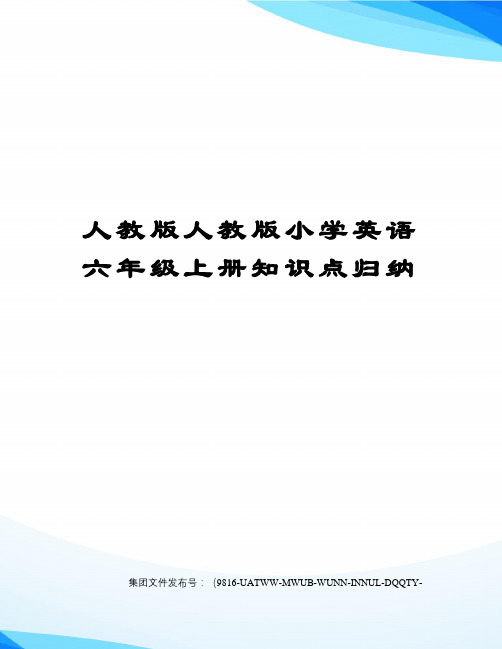
人教版人教版小学英语六年级上册知识点归纳集团文件发布号:(9816-UATWW-MWUB-WUNN-INNUL-DQQTY-人教版(PEP)小学英语总复习六年级上册知识点Unit1Howcan I get there一、主要单词:museum博物馆 bookstore书店 cinema电影院 turn 转弯 hospital医院 left向左 post office 邮局 science科学right向右straight笔直地 crossing十字路口二、习惯语搭配:post office邮局 science museum科学博物馆 pet hospital宠物医院Italian restaurant意大利餐馆 Beihai Park北海公园 Palace Museum 故宫博物院 go straight直走 turn right/left右/左转 next to挨着in front of...在...前面 near the park在公园附近 on Dongfang Street在东方大街上三、惯用表达式:Excuse me 打扰一下 Follow me, please!请跟着我!四、公式化句型:1、问路的句型及其答语:问句:Where is the + 地点?···在哪儿?答语:It’s + 表示地点的词语。
它···。
2、询问怎么到某地的句型及其答语:问句:How can +主语 + get (to)+地点···怎么到···同义句型:Can you tell me the way to +地点Where is + 地点Which isthe way to +地点答语:Turn +方向+表示地点的介词短语。
···转。
五、例句:Whereisthecinema,please请问电影院在哪里?It’snexttothehospital. 它与医院相邻。
六年级英语上册《句型专项》练习题-附答案(人教版)
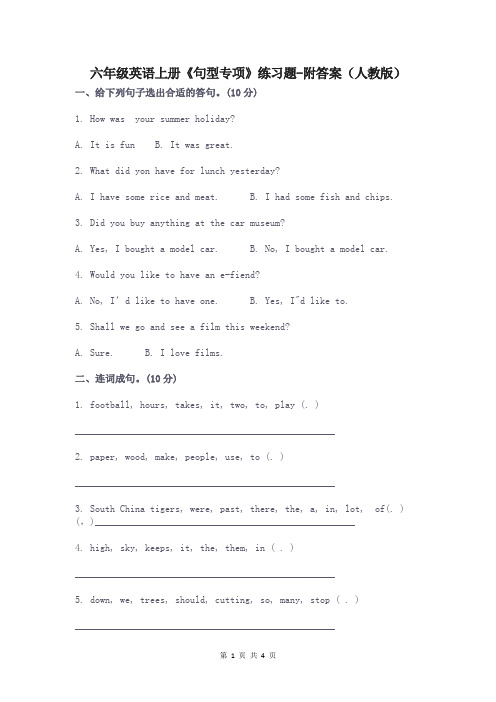
六年级英语上册《句型专项》练习题-附答案(人教版)一、给下列句子选出合适的答句。
(10分)1. How was your summer holiday?A. It is funB. It was great.2. What did yon have for lunch yesterday?A. I have some rice and meat.B. I had some fish and chips.3. Did you buy anything at the car museum?A. Yes, I bought a model car.B. No, I bought a model car.4. Would you like to have an e-fiend?A. No, I’d like to have one.B. Yes, I"d like to.5. Shall we go and see a film this weekend?A. Sure.B. I love films.二、连词成句。
(10分)1. football, hours, takes, it, two, to, play (. )____________________________________________________2. paper, wood, make, people, use, to (. )____________________________________________________3. South China tigers, were, past, there, the, a, in, lot, of(. ) (,)____________________________________________________4. high, sky, keeps, it, the, them, in ( . )____________________________________________________5. down, we, trees, should, cutting, so, many, stop ( . )____________________________________________________三、按要求改写下列句子。
人教版六年级英语上册全册重点句型复习
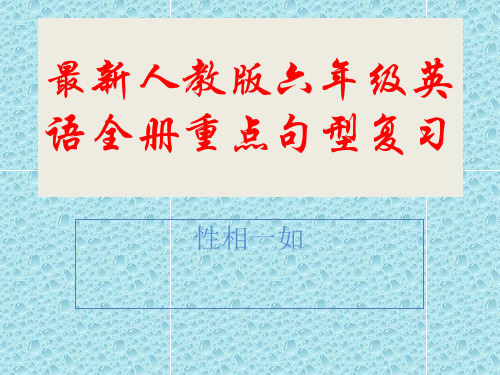
性相一如
1、Where Is the hospital? It’s in front of the cinema.
问路句型
Where is +地点? It’s +表示位置的短语。
2、How can we get there? Turn left at the bookstore.
• Hobbies, are, what, your(?) • What are your hobbies? • Like,she,dancing,does(?) • Does she like dancing? • Live, I, in, Changsha(.) • I live in Changsha. • I,like, reading, stories,also(.) • I also like reading stories.
2、以不发音的字母e结尾,去e加ing • 如make---making,write---writing • 末尾只有一个辅音字母的重读闭音节,双写末
尾辅音字母,再加ing,如stop—stopping, begin--beginning
Does he live in Sydney? No,he doesn’t.
做什么的?
Where does he work? He works at sea .
询问他人的工作地点 Where does +主语(第三人称单数)+work? He/She works +表示地点的介词短语 询问他人上班方式句型及答语 How does +主语(第三人称单数 )+go to work? He/She goes to work +出行方式(by bike , on foot , by bus …)
六年级英语上册 人教PEP版 期中复习 句型专题

重点句型
ually, I go on foot.通常我走路去。 同义句:Usually, I walk. *频率副词,用来表示事情发生的频率,即某事多长时间 发生一次。 如:always总是,usually通常,often经常, sometimes有时,never从不等。
重点句型
4.In the USA people on bikes must wear one. 在美国骑自行车的人必须戴(头盔)。 *句型结构:某人 + must + 动词原形( + 其他). must是情态动词,意为“必须”语气很强烈, 没有人称和数的变化,后面接动词原形。
重点句型
4.Don't go at the red light! 别闯红灯! *句型结构:Don’t + 动词原形( + 其他). 此种结构在英语中被称为否定祈使句, 用来提醒和警告别人不要做某事。 例如:Don’t smoke. 禁止吸烟。
Don’t take photos. 禁止拍照。
重点句型
重点句型
4.Turn left at the bookstore. 到书店左转。
*指路:Turn +方向+表示地点的介词短语。 ···转。
重点句型
5. I want to buy a postcard.
① want + sth 想要某物 eg. I want an orange.
② want + to + 动词原形 想要做某事 eg. I want to buy a pair of shoes.
In front of the school. 在学校的前面.
重点句型
3.How can we get there? 我们怎么到那儿? *此句用来询问“怎样去某地”, 后面直接跟地点。 回答 时, 可用“ Turn left, turn right, go straight.”等句来回答 。 How can we get cinema? 我们怎么到电影院? Turn left at the bookstore. 到书店左转。
人教版六年级英语上册《Unit 1 How can I get there》重点难点知识梳理

人教版六年级英语上册《Unit 1 How can I getthere?》重点难点知识梳理重点:询问某地在哪里的问句及其答语询问怎样到某地的句型动词want的用法难点:能够问路并描述路线Wha引导的感叹句四会单词短语science科学museum博物馆bookstore书店cinema电影院hospital医院crossing十字路口tumn转弯left左straight笔直地right右post office邮局三会单词短语ask问sir(对男子的礼貌称呼)先生interesting有趣的Italian意大利的restaurant餐馆pizza比萨饼street大街;街道get到达GPS全球(卫星)定位系统gave(give的过去式)提供;交给feature特点follow跟着far较远的tell告诉get to到达in front of…在……前面惯用表达式1.Excuse me.打扰了。
2.I don't know.我不知道。
3.Follow me,please!请跟着我!重点句式或句型1.- Robin,where is the museum shop?罗宾,博物馆的商店在哪儿?-It's near the door.它在大门附近。
解读:这是询问某地在哪里的问句及其答语。
句型结构:问句:Where is+地点(the bookstore,your school…)?答语:It's+表示地点的词语(near the park,over there,next to the school…).2.- How can we get there?我们怎么能到达那儿?-Turn left at thebookstore. Then turn right at the hospital到书店左转。
然后到医院右转。
解读:这是询问怎样到某地的问句及其答语。
句型结构:How can+主语+get(to)+地点?3.表示到某地向左转/向右转的句型Turn left /right at+地点.了解句型1.I want to buy a postcard.我想要买一张明信片。
六年级英语-上册复习资料(1)

人教版(PEP)小学英语总复习六年级上册知识点Unit 1 How can I get there ?一、主要单词:museum博物馆bookstore书店cinema电影院turn 转弯hospital医院left向左post office 邮局science科学right向右straight笔直地crossing十字路口二、习惯语搭配:post office邮局science museum科学博物馆pet hospital宠物医院Italian restaurant意大利餐馆Beihai Park北海公园Palace Museum故宫博物院go straight直走turn right/left右/左转next to挨着in front of。
..在。
.。
前面near the park在公园附近on Dongfang Street在东方大街上三、惯用表达式:Excuse me 打扰一下Follow me, please!请跟着我!四、公式化句型:1、问路的句型及其答语:问句:Where is the + 地点? ···在哪儿?答语:It’s + 表示地点的词语。
它在···。
例句:where is the cinema?It’s next to the bookstore。
2、询问怎么到某地的句型及其答语:问句:How can +主语+ get (to)+地点?···怎么到···?例句:How can I get to the bookstore?同义句型:Can you tell me the way to +地点?Where is + 地点?Which is the way to +地点?答语:Turn +方向+表示地点的介词短语。
···转.例句:turn right at the hospital.五、例句:Where is the cinema, please?请问电影院在哪里?It's next to the hospital. 它与医院相邻。
人教版-英语-六年级上册-Unit1 The Great Wall 语法句型

Unit1 The Great Wall长城知识详解重难点1.你会夸赞这些东西很棒吗?—These…are great!课文应用:These postcard are great!这些明信片太棒了!句型结构These+可数名词复数+are great!重点解析these意为“这些”,后面要接可数名词复数形式。
因为此句型中的主语是可数名词复数形式,所以be动词用are。
great意为“美妙的;好极的”。
生活实例Gao Ming看了朋友收集的一些邮票,他觉得这些邮票太棒了。
让我们来看一看Gao Ming是怎样表达的:知识链接含义丰富的“great”表示“大的;巨大的”。
例如:There is a great tree in front of our house.我们的屋前有一棵大树。
表示“伟大的;优秀的”。
例如:Einstein is a great scientist.爱因斯坦是一位伟大的科学家。
表示“美妙的;好极的”。
例如:What a great idea!多么好的一个主意啊!That sounds great!那听起来好极了!可数名词和不可数名词在英语中,名词按它们所表示的事物的性质不同可以分为可数名词和不可数名词。
不可数名词是指不能以数目来计算的词,一般没有复数形式。
例如:work工作,meat肉。
可数名词是指能以数目来计算的词,因此它有复数形式。
其复数形式的变化有以下几种情况(详见下表):少数名词复数形式的变化是不规则的。
例如:man-men男人,woman-women女人,tooth-teeth牙齿,child-children儿童。
2.如何表达“它是一张……的照片”-It's a picture of...课文应用:It's a picture of the Great Wall.它是一张长城的照片。
句型结构It's a picture of+某人/某物.重点解析picture在这个句型中的意思是“照片”,相当于photo。
人教版英语书六年级上册第一单元的重点语法

人教版英语书六年级上册第一单元的重点语法
以下是六年级上册第一单元的重点语法:
现在进行时
现在进行时是英语中表示正在进行的动作或存在的状态的时态。
其结构为“be动词+动词ing形式”,其中be动词随主语变化而变化,动词ing形式保持不变。
例句:
- What are you doing now? (你现在正在做什么?)
- I am writing a letter. (我正在写信。
)
时间状语从句
时间状语从句用来表示动作发生的时间,常用的引导词有when、while等。
例句:
- When did you finish your homework? (你什么时候完成作业的?)
- While I was watching TV, my mom called me. (当我正在看电视的时候,妈妈给我打了电话。
)
祈使句
祈使句表示请求、命令或建议等,常用动词原形开头,常用于口语中。
例句:
- Please sit down. (请坐下。
)
- Don't talk loudly in the library. (在图书馆里不要大声说话。
)。
小学人教PEP英语六年级上册重点单词、短语、句型汇总
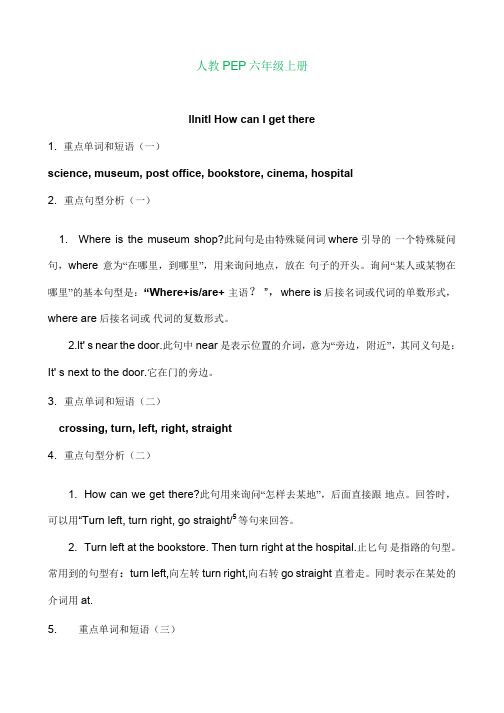
人教PEP六年级上册llnitl How can I get there1. 重点单词和短语(一)science, museum, post office, bookstore, cinema, hospital2. 重点句型分析(一)1. Where is the museum shop?此问句是由特殊疑问词where引导的一个特殊疑问句,where意为“在哪里,到哪里”,用来询问地点,放在句子的开头。
询问“某人或某物在哪里”的基本句型是:“Where+is/are+ 主语?”,where is后接名词或代词的单数形式,where are后接名词或代词的复数形式。
2.lt' s near the door.此句中near是表示位置的介词,意为“旁边,附近”,其同义句是:It' s next to the door.它在门的旁边。
3. 重点单词和短语(二)crossing, turn, left, right, straight4. 重点句型分析(二)1. How can we get there?此句用来询问“怎样去某地”,后面直接跟地点。
回答时,可以用“Turn left, turn right, go straight/5等句来回答。
2. Turn left at the bookstore. Then turn right at the hospital.止匕句是指路的句型。
常用到的句型有:turn left,向左转turn right,向右转go straight直着走。
同时表示在某处的介词用at.5. 重点单词和短语(三)Tasty, buy, London Eye, next to, far from, go straight, turn left, stomach 6. 重点句型分析(三)Is the Thames far from here? No.此句是个be动词开头的一般疑问句,其回答要用yes或no.句中的far from意为“离 ............................................. 远”。
人教版PEP六年级上册英语unit1必背短语句子
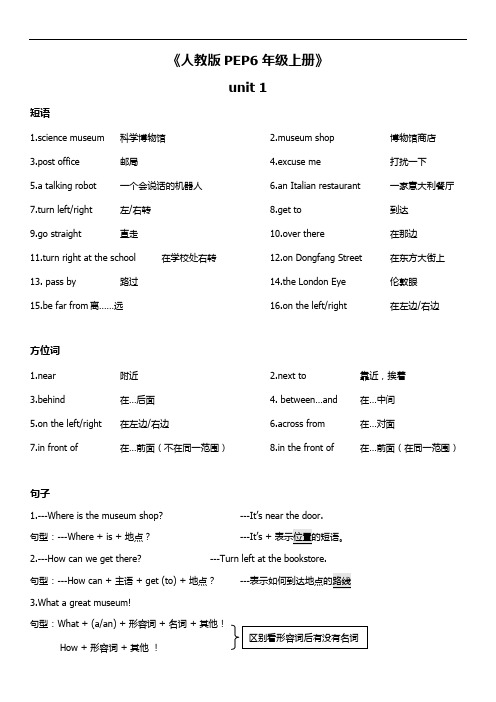
《人教版PEP6年级上册》unit 1短语1.science museum 科学博物馆2.museum shop 博物馆商店3.post office 邮局4.excuse me 打扰一下5.a talking robot 一个会说话的机器人6.an Italian restaurant 一家意大利餐厅7.turn left/right 左/右转8.get to 到达9.go straight 直走10.over there 在那边11.turn right at the school 在学校处右转12.on Dongfang Street 在东方大街上13. pass by 路过14.the London Eye 伦敦眼15.be far from 离……远16.on the left/right 在左边/右边方位词1.near 附近2.next to 靠近,挨着3.behind 在…后面4. between…and 在…中间5.on the left/right 在左边/右边6.across from 在…对面7.in front of 在…前面(不在同一范围)8.in the front of 在…前面(在同一范围)句子1.---Where is the museum shop? ---It’s near the door.句型:---Where + is + 地点?---It’s +2.---How can we get there? ---Turn left at the bookstore.句型:---How can + 主语 + get (to) + 地点?---3.What a great museum!句型:What + (a/an) + 形容词 + 名词 + 其他!How + 形容词 + 其他!。
人教PEP版六年级英语上册Unit-1专项训练-句型转换(有答案)

人教PEP版六年级英语Unit1单元专项训练单项选择一、按要求完成句子。
(参考答案)一、按要求完成句子。
1.Where is the park?2.Where cinema3.Is here4.The cinema is in front of the post office.5.There is an orange./There’s an orange.6.No,it isn’t.7.It’s next to the cinema./It is next to the cinema.8.Where is the hospital?9.Where is10.No there isn’t11.There is a supermarket near here.12.Is there a cinema near here?13.Is there a school behind the bookstore?14.Where is the library?15.What an interesting film!16.No,there isn’t.17.Don't turn left18.Is there19.right at20.Where is21.What a great park!22.What a23.Yes,there is.24.behind25.Yes,it is.26.There isn't a museum in the city.27.Where is the pet shop?28.You can go to the zoo by bus today.29.don’t30.Is the cinema near here?31.He wants to go to the bookstore./He wants to go to the bookshop.32.in front of33.goes to34.What an interesting book!/How interesting the book is! 35.Yes,there is.36.Can you go to school by bike?37.Where is the library?38.The shop is in front of the cinema.。
小学人教版六年级英语上册复习要点

小学人教版六年级英语上(Shang)册复习要点Unit1 How can I get there?一(Yi)、重点单词:地(Di)点:science museum科学(Xue)博物馆 post office 邮局 bookstore 书店cinema 电影院 hospital 医院动(Dong)作:go straight 直(Zhi)走 turn left/right 左转、右转方(Fang)位: in front of :在(Zai)···前面 behind 在···后面near在…旁边 next to 紧挨着 beside 在旁边over 在…上方 on the left 在左边 on the right 在右边二、重点句型:(1)Is / Are there…?某处有某物吗?肯定回答:Yes, there is/are. 否定回答:No, there isn’t/aren’t.(2)Where is the + 地点? ... ... 在哪里?It’s + 表示地点的名词. 它... ...例句:Where is the cinema? 电影院在哪?It’s next to the bookstore. 在书店的旁边。
(3)How can + 主语+get(to)+ 地点? ... ...怎么到... ...?(如果get后面接的词为副词,则要省略介词to.)例句:How can we get to the park?How can we get there? 我们怎么到那儿?同义句型:Can you tell me the way to + 地点?( 4 )Where is + 地点? Which is the way to + 地点?( 5 ) Turn left at the bookstore. 到书店左转。
Unit 2 Ways to go to school?一、重点单词/短语:交通方式:by bike /bus /plane /subway /train /ship /taxi /ferry骑自行车/乘公共汽车/飞机/地铁/火车/船/出租汽车/轮渡take the No.57 bus 乘57路公共汽车on foot 步行其他:slow down慢下来 pay attention to 注意 traffic lights 交通信号灯 look right 向右看 cross the road 横穿马路 at home 在家二、重点句型:(1)How do you + 地点?你们怎么来... 的?I usually/ often/sometimes .. ... 我通常/经常/有时...How do you go(to) + 地点?你们怎么去...的?How do you get (to) + 地点?你们怎(Zen)么到达...的?(频度副词:频度副词又称频率副词,用来表示事情发(Fa)生的频率,即某事多主语 + must + 动词原(Yuan)形 + (其它)(must和(He)can, should一样都是情态动(Dong)词,must意(Yi)思是“必(Bi)须”,语气很强烈,没有人称和数的变化,后面接动词原形。
- 1、下载文档前请自行甄别文档内容的完整性,平台不提供额外的编辑、内容补充、找答案等附加服务。
- 2、"仅部分预览"的文档,不可在线预览部分如存在完整性等问题,可反馈申请退款(可完整预览的文档不适用该条件!)。
- 3、如文档侵犯您的权益,请联系客服反馈,我们会尽快为您处理(人工客服工作时间:9:00-18:30)。
一、根据图片判断句子正(T)误(F)。
()1.Jim is going to the zoo by bike.
()2.Tom is writing an email.
()3.Lily is going to visit her aunt next weekend.
()4.Oliver is reading stories.
()5.Ken is going to take a trip tomorrow.
二、单项选择。
()1.—What your sister ?
—She is cleaning her room.
A.is,do
B.does,do
C.is,doing ()2.They are going to see a film .
A.now
B.tonight
C.on Mondays ()3.Listen!Someone .
A.sing
B.sings
C.is singing ()4.Amy to the nature park tomorrow.
A.goes
B.will go
C.go
()5.My brother food in the kitchen now.
A.is eating
B.is eating
C.are eating ()6.Mike football this weekend.
A.will plays
B.is going to play
C.is playing ()7.Bob here tomorrow.
A.won’t is
B.isn’t going to
C.won’t be ()8.—are you going to do tonight?
—I’m going to buy a book.
A.What
B.do,go
C.How
()9.—When you ?
—At 4:00 this afternoon.
A.are,going
B.do,go
C.will,going ()10.The students having breakfast now.
A.is
B.are
C.be
三、用所给词语的适当形式填空。
1.Look! It (rain) now.
2.My parents (not watch) TV now.
3. she (run) now?
4.Jim (have) an art lesson tomorrow.
5.When are we (leave)?
四、给下列问句选择正确的答语。
()1.What is Tina doing?
()2.Where are you going?
()3.What are you going to do tonight?
()4.Is Miss White reading a book now?
()5.Are Wu Yifan and Robin going to read stories?
A.Yes,she is.
B.I’m going to the museum.
C.No,they aren’t.
D.She is dancing.
E.We are going to study Chinese.
五、按要求改写句子。
1.He is going to buy a word book tomorrow.(改为否定句)
2.Jack is going to take a trip next Monday.(对画线部分提问)
3.Lily is doing word puzzles now.(对画线部分提问)
4.I’m going at 2:00 o’clock.(对画线部分提问)
5.We’re going to the cinema tonight.(对画线部分提问)
六、看图回答问题。
1.—What is Lee doing now?
—He .
2.—Is he playing football?
—No, .
3.—What are you going to do tomorrow?
—.
4.—What is Li Ming going to do tomorrow?
—He .
5.The cat the mouse now.
七、找出错误的一项并改正。
()1.I’m going to singing on English song tomorrow.
A B C
()2.—What are you going to do?
A
—I’m going to going shopping.
B C
()3.Mike and Jim will going to the park next week.
A B C
()4.Tom and I am going to play football this afternoon.
A B C
()5.Joe is swiming in the lake.
A B
()6.—When are you going this afternoon?
A B
—To the museum shop.
C
参考答案:
一、1.F 2.T 3.F 4.T 5.F
二、1.C 2.B 3.C 4.B 5.A 6.B 7.C 8.A 9.a 10.b
三、1.is raining 2.aren’t watching 3.Is,running 4.is going to have/will have
5.leaving
四、1.D 2.B 3.E 4.A 5.C
五、1.He isn’t going to buy a word book tomorrow.
2.What is Jack going to do next Monday?
3.What is Lily doing now?
4.When are you going?
5.Where are you going tonight?
六、1.is flying a kite 2.he isn’t 3.I’m going to do word puzzles.
4.is going to visit his grandparents
5.is chasing
七、1.B sing 2.B go 3.A go 4.C are 5.B swimming 6.A Where。
